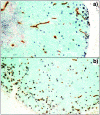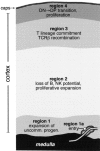Mapping precursor movement through the postnatal thymus reveals specific microenvironments supporting defined stages of early lymphoid development
- PMID: 11457887
- PMCID: PMC2193450
- DOI: 10.1084/jem.194.2.127
Mapping precursor movement through the postnatal thymus reveals specific microenvironments supporting defined stages of early lymphoid development
Abstract
Cellular differentiation is a complex process involving integrated signals for lineage specification, proliferation, endowment of functional capacity, and survival or cell death. During embryogenesis, spatially discrete environments regulating these processes are established during the growth of tissue mass, a process that also results in temporal separation of developmental events. In tissues that undergo steady-state postnatal differentiation, another means for inducing spatial and temporal separation of developmental cues must be established. Here we show that in the postnatal thymus, this is achieved by inducing blood-borne precursors to enter the organ in a narrow region of the perimedullary cortex, followed by outward migration across the cortex before accumulation in the subcapsular zone. Notably, blood precursors do not transmigrate the cortex in an undifferentiated state, but rather undergo progressive developmental changes during this process, such that defined precursor stages appear in distinct cortical regions. Identification of these cortical regions, together with existing knowledge regarding the genetic potential of the corresponding lymphoid precursors, sets operational boundaries for stromal environments that are likely to induce these differentiative events. We conclude that active cell migration between morphologically similar but functionally distinct stromal regions is an integral component regulating differentiation and homeostasis in the steady-state thymus.
Figures




References
-
- Shortman K., Egerton M., Spangrude G.J., Scollay R. The generation and fate of thymocytes. Semin. Immunol. 1990;2:3–12. - PubMed
-
- Shimonkevitz R.P., Husmann L.A., Bevan M.J., Crispe I.N. Transient expression of IL-2 receptor precedes the differentiation of immature thymocytes. Nature. 1987;329:157–159. - PubMed
-
- Lesley J., Trotter J., Schulte R., Hyman R. Phenotypic analysis of the early events during repopulation of the thymus by the bone marrow prothymocyte. Cell. Immunol. 1990;128:63–78. - PubMed
-
- Ceredig R., Lowenthal J.W., Nabholz M., MacDonald H.R. Expression of interleukin-2 receptors as a differentiation marker on intrathymic stem cells. Nature. 1985;314:98–100. - PubMed
Publication types
MeSH terms
Grants and funding
LinkOut - more resources
Full Text Sources
Other Literature Sources

